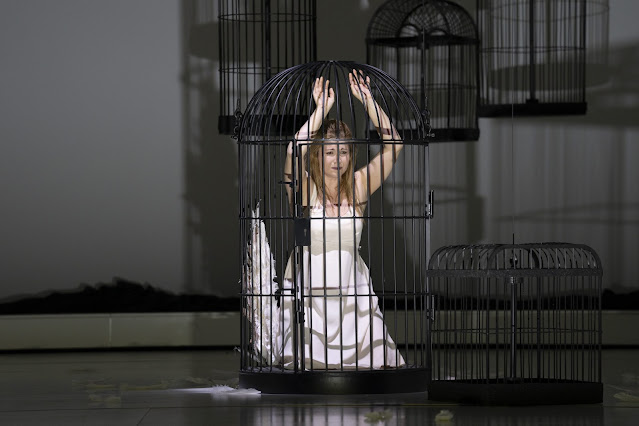 |
| Janáček: Káťa Kabanová – Kateřina Kněžíková – Glyndeburne (Photo: Richard Hubert Smith) |
Janáček: Káťa Kabanová; Kateřina Kněžíková, Nicky Spence, Rachael Wilson, Sam Furness, Susan Bickley, John Tomlinson, director: Damiano Michieletto/Eleanora Gravagnola, London Philharmonic Orchestra, conductor: Robin Ticciati; Glyndebourne Opera
Reviewed 3 August 2025
For all the ideas that director Damiano Michieletto threw at the work, it was in the pit and in the singing that the real drama happened, centred on an all-consuming performance from Kateřina Kněžíková in the title role
From the late 1980s onwards, productions of Janáček’s works at Glyndebourne were associated with the director Nikolaus Lehnhoff but this changed in 2021 when Damiano Michieletto directed a new production of Janáček’s Káťa Kabanová. On 3 August 2025 the production returned to Glyndebourne for its first revival, with Eleonora Gravagnola as revival director. Robin Ticciati conducted the London Philharmonic Orchestra with Kateřina Kněžíková returning to the title role, plus Sam Furness as Kudrjáš, Sarah Pring as Glaša, John Tomlinson as Dikoj, Nicky Spence as Boris, Rachel Roper as Fekluša, Susan Bickley as Kabanicha, Jaroslav Březina as Tichon, Rachael Wilson as Varvara, and Charles Cunliffe as Kuligin. Designs were by Paolo Fantin and costumes by Carla Teti.
I never saw the 2021 production, but it seems to have undergone some adjustment in the intervening years. Gone are the dancers and the choreographer, whilst the angel that haunts the stage has changed from man to woman with a significant costume change.
Janáček’s opera, using his own libretto based on Ostrovsky’s play, The Storm, features the natural world quite strongly as a mirror of his protagonists’ emotions. The work begins and ends by the river Volga, at first calm and being admired and at the end as part of the storm which reflects Káťa’s emotional turmoil. Michieletto and his designers eschew this for a feeling of clear modernism. Paolo Fantin’s sets were white with just a stylish white leather sofa as dressing. Clearly not only are the Kabanov’s rich merchants but they live in some style. Costumes were modern with a hint of the 1950s particular about the women’s dresses, whilst Káťa and Varvara both sported very high heels.
Not only did Michieletto eschew depicting the natural world, but he barely sketched in the community surrounding the Kabanovs. In Act One, there was little sense of the family returning from church, surely an important point, whilst in the final act the chorus were all frustratingly off stage.
Michieletto played this purely as a chamber drama, focusing on the title role and those around her, whilst populating the stage with artefacts from Káťa’s thoughts. The image of caged birds, taken from her Act One aria, was important throughout with Michieletto developing this in Act Three to Káťa herself as a caged bird. And when she sang about her heart being weighed down by a stone, then we got a stone. Most confusingly, during her Act One scene when she talked about angels, an angel appeared and haunted the stage for much of the opera. The angel appeared to be shedding its feathers, and the image of feathers dropping is another one that Michieletto mined, then during the marvellous scene at the end of Act Two when the duets of Kudrjáš and Varvara, and Káťa and Boris intertwine and contrast, Michieletto introduced the figure of Kabanicha who proceeded to remove further feathers from the angel and then lock her up in a cage. This seemed an unnecessary gloss, and throughout the opera I felt that Michieletto was overkeen on pointing out what we should be thinking, what references we should pick up on. The result felt fussy and at times somewhat cool.
What brought the work alive were the marvellous musical performances including the sheer intensity of Kateřina Kněžíková in the title role. Kněžíková’s voice had the lyrical flexibility to suggest Káťa’s youth and inexperience, but also the focused power to bring off her later scenes. She was anxious from the word go, but this went hand in hand with youthfulness. This Káťa was never neurotic, but she was concerned with her place in the world. Her Act Two scene with Nicky Spence’s Boris never quite achieved rapture, this was two damaged souls who never quite touched. In Act Three, Kněžíková was completely heart-breaking in the way she combined intensity with a feeling of being lost. This was a highly communicative performance, despite the fact that Michieletto kept introducing concepts into the staging.
Spence’s Boris was another lost soul, under the thumb of his dominating uncle, unable to either take Káťa for himself or leave her alone. Spence brilliantly brought out the tentative nature of Boris’ regard for Káťa, the way he could not help himself and almost egged her on. In Act Three, faced with her breakdown, he was completely lost. Jaroslav Březina’s Tichon was just as unsatisfactory, unable either to satisfy his mother or two defend and support his wife, reverting to the bottle even as he tries to convince us he does love her.
Susan Bickley was a wonderfully stylish yet vicious Kabanicha. This was a depiction straight out of some American soap in that this Kabanicha said everything with icy politeness yet always with a stiletto. There was little sense of relish, she seemed quite detached. In the scene with John Tomlinson’s Dikoj she treated him with the same sort of disdain and there was little sense of the sexual element to their interaction. Or at least not from Bickley’s Kabanicha, though Tomlinson’s Dikoj was far more suggestive.
Sam Furness and Rachael Wilson made a wonderfully contrasting couple, eager and engaging yet down to earth. Furness’ Kudrjáš saw things clearly and was trenchant in his advice to Boris whilst Wilson made Varvara a real breath of fresh air, yet one who saw the real Káťa. Their folk-song duetting in Act Two was life-enhancing, contrasting with the sheer intensity of .Kněžíková and Březina.
John Tomlinson’s Dikoj was a complete tour de force and would have been in danger of pulling focus except he was surrounded by equally strong players. Sarah Pring made Glaša really count, whilst Rachel Roper had a strong presence as Fekluša, with Charles Cunliffe giving support as Kuligin.
In the pit Robin Ticciati and the London Philharmonic Orchestra were on marvellous form, giving an account of the score which was full of vibrant life and with all the little folk elements resonating along with the myriad complexities that Janáček creates. The sound was lithe, yet from the first time the timpani motto came in during the prelude, we knew that the music was going somewhere. Ticciati and his players took us on a real journey, and for all the ideas that Michieletto threw at the work, it was in the pit and in the singing that the real drama happened.
The blog is free, but I’d be delighted if you were to show your appreciation by buying me a coffee.
Elsewhere on this blog
- BBC Proms – Arvo Pärt at 90: Estonian Philharmonic Chamber Choir, Tõnu Kaljuste – concert review
- Baltic Tides: piano music by two important Baltic pianist composers, Lūcija Garūta & Ester Mägi makes for a marvellous, compelling disc – record review
- Frederick and his sister: music for Postsdam and Bayreuth created for Frederick the Great and Wilhelmine of Bayreuth – record review
- Passion project that deserves to be enjoyed: Alastair Penman’s The Last Tree – record review
- To honour the women by giving voice to their experience: pianist Deirdre Brenner introduces The Magdalene Songs – interview
- Satisfying all round: Opera Holland Park’s revival of its 2018 production of Verdi’s La traviata showcases a trio of fine principals – opera review
- Will definitely stay in the memory: Gweneth Ann Rand & Simon Lepper in Judith Weir’s woman.life.song at Wigmore Hall – concert review
- Style & substance: Ambroise Thomas’ Hamlet in Buxton is a rewarding musical & dramatic feast – opera review
- The ennui of modern life: Bernstein & Poulenc’s one-act operas from the 1950s in an intriguing double bill at Buxton International Festival – review
- Old-fashioned drama & a modern gloss: Cecilia Stinton directs Donizetti’s Lucia di Lammermoor at Opera Holland Park with Jennifer France – review
- Home





.jpg?w=670&resize=670,446&ssl=1)




